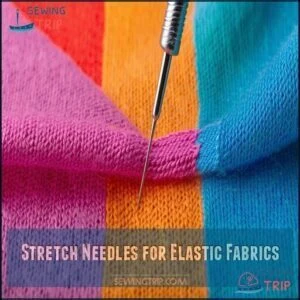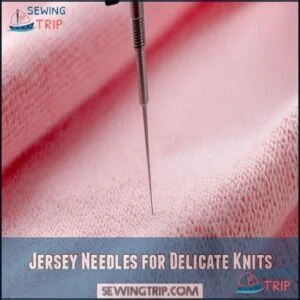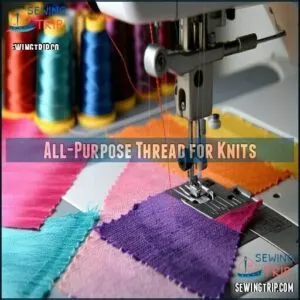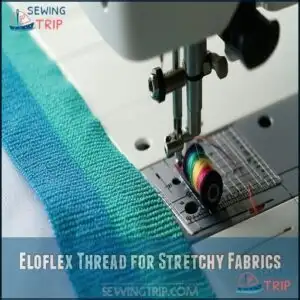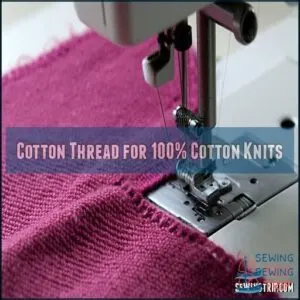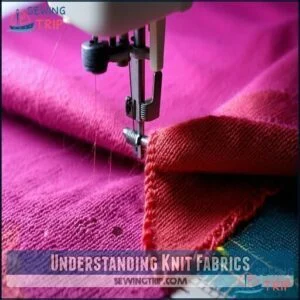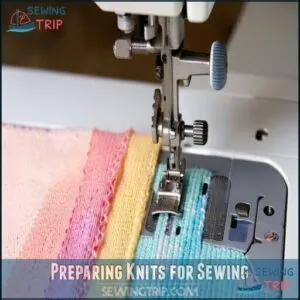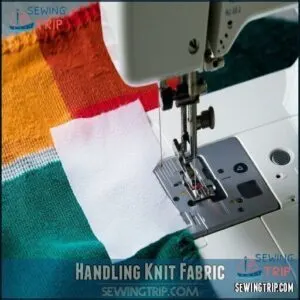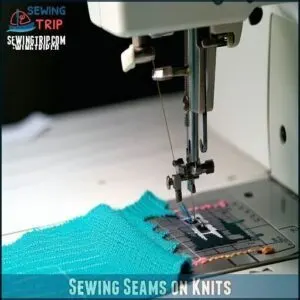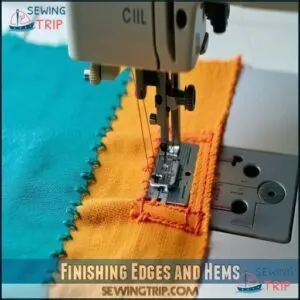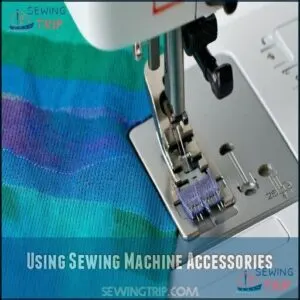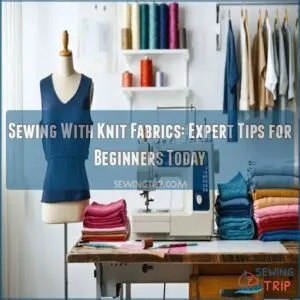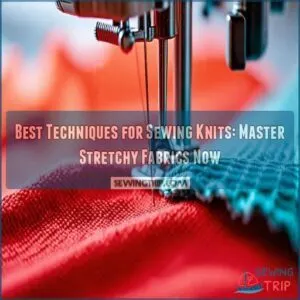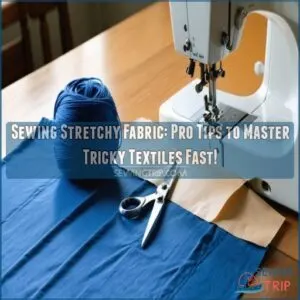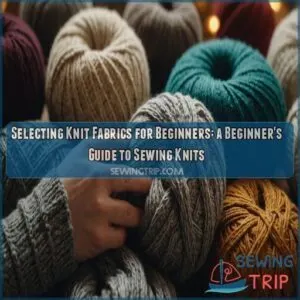This site is supported by our readers. We may earn a commission, at no cost to you, if you purchase through links.
 When you’re sewing knit fabrics on your machine, you’ll need a few special tricks.
When you’re sewing knit fabrics on your machine, you’ll need a few special tricks.
Start with a ballpoint or stretch needle that glides between fabric fibers instead of piercing them. Set your machine to a flexible stitch—like a narrow zigzag or lightning stitch—that moves with the fabric when stretched.
Don’t pull the fabric while sewing; let your feed dogs do the work. A walking foot can be your best friend here, like training wheels for slippery knits.
Reduce your presser foot pressure to prevent waves and ripples. Those stubborn seams that once made you want to toss your machine might just become your next favorite project.
Table Of Contents
Key Takeaways
- You’ll get the best results with knit fabrics by using ballpoint or stretch needles that glide between fabric fibers instead of piercing them, preventing holes and snags.
- You’ll need to use flexible stitches like narrow zigzag or lightning stitch that move with the fabric when stretched, and adjust your stitch length and width based on your specific knit fabric type.
- You’ll want to reduce your presser foot pressure to prevent waves and ripples, and consider using a walking foot to evenly feed stretchy or slippery knits through your machine.
- You’ll find that proper fabric handling makes a huge difference—avoid pulling the fabric while sewing, support the fabric’s weight for even seams, and use tissue paper for added stability with lightweight knits.
Choosing Right Needles
You’ll save yourself a mountain of frustration by grabbing the right needle for your knit fabric.
Ballpoint or stretch needles glide between the fibers instead of piercing them, preventing those pesky holes and snags that can ruin your stretchy masterpiece.
Ballpoint Needles for Knits
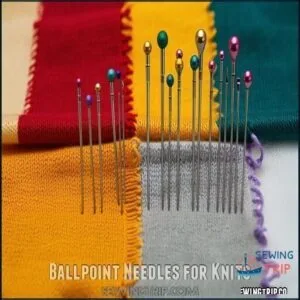
Your secret weapon in the knit fabric battle is the right needle.
Ballpoint needles have rounded tips that glide between knit fibers without damaging them.
For lightweight knits, grab a 70/10 size; heavier knits need 100/16.
They’re essential for spandex fabrics and prevent laddering.
While universal needles can work in a pinch, quality ballpoint needles from trusted brands guarantee hole-free, professional results.
You can find various needle types for different projects.
Stretch Needles for Elastic Fabrics
While ballpoint needles are great, stretch needles take your elastic fabric sewing to the next level.
They feature a deeper shank and longer scarf, dramatically reducing those frustrating skipped stitches and improving thread looping.
When you’re working with spandex or swimwear fabrics, these needles are your best friends.
Consider using specialized sewing tools for best results.
The needle size matters too—choose smaller ones (75/11) for lightweight stretchy materials and larger sizes (90/14) for heavier knit fabrics.
Jersey Needles for Delicate Knits
Jersey needles often make all the difference when working with delicate knits. Their slightly rounded tips slide between fabric fibers rather than piercing them, which is essential for preventing runs and fabric snagging.
- Your lightweight jersey fabrics will thank you!
- Say goodbye to those frustrating ladder-like holes
- Different needle brands offer varying point types
- Schmetz and Organ needles are top picks among pros
Choose the right needle size – size 70/10 for fine knits, 80/12 for medium weights. This will ensure that you get the best results and prevent damage to your fabric, making it a crucial step in working with delicate knits.
Selecting Thread Types
You’ll need the right thread to keep your knit fabric seams strong and stretchy.
Just like picking the perfect dance partner, matching your thread to your fabric type guarantees your seams won’t pop when your knit garment stretches and moves.
All-Purpose Thread for Knits
All-purpose thread is your sewing workhorse when tackling knit projects.
It works beautifully for most knit fabrics and comes in countless colors for perfect matching. The thread composition offers enough give without compromising seam durability, making it cost effective for everyday sewing.
For best results, consider matching thread weight to the fabric. While fancy specialty threads have their place, good quality all-purpose thread rarely causes issues in your knit garments, making it a reliable choice for everyday sewing.
Eloflex Thread for Stretchy Fabrics
While all-purpose thread works for many knits, when you’re tackling super stretchy fabrics like swimwear or leggings, Eloflex thread is your new best friend.
This specialty thread stretches with your fabric for maximum durability. You can easily buy Eloflex thread online.
- Eloflex maintains seam integrity even when fabric is stretched to its limits
- Perfect for swimwear applications where regular thread might snap
- Available in fewer colors than all-purpose thread, so plan your color matching ahead
- Can be used in both bobbin and top threading for consistent stretch
Cotton Thread for 100% Cotton Knits
Many experienced sewists swear by cotton thread when working with 100% cotton knits.
It prevents those annoying holes that sometimes form in seams when using polyester thread. The matching fiber content creates better seam durability while maintaining stretch.
For best results on your sewing machine, match your thread color to your fabric and use a slightly looser tension for smooth, professional-looking seams on knit fabrics, which helps in achieving better seam durability.
Understanding Knit Fabrics
You’ll need to understand the different types of knit fabrics before your sewing machine can work its magic.
Once you know how much your fabric stretches and which direction it moves most, you’ll avoid those frustrating wavy seams that can turn your cute top into a wrinkly mess, which is why understanding fabric stretch is critical.
Know Your Knit Fabrics
Now that you’ve got your thread sorted, let’s talk about the fabric itself.
Knit fabrics aren’t all created equal. The knit construction types dramatically affect how they behave under your needle.
Fabric weight matters too—lightweight jersey needs different handling than ponte. Check the knit fiber content and blends—cotton knits sew differently than rayon or polyester blends.
Understanding drape and recovery will help you choose the right techniques for your project. Many projects use jersey knit fabric because it’s soft and stretchy.
Learn How to Figure Out Stretch Percentage
Now that you understand different knit fabrics, let’s tackle stretch percentage—your secret weapon for perfect-fitting garments.
To calculate stretch, grab a ruler and a 4"/10cm fabric strip.
Measure your fabric at rest, then stretch it to its max, and use this simple formula: (stretched length – original length) ÷ original length × 100 = stretch percentage.
For example, if 4" stretches to 5", that’s a 25% stretch fabric.
Fabric Types and Their Stretch
Now that you know how to measure stretch, let’s talk about the different types of knit fabrics you’ll encounter.
Knit fabrics come in various stretch capabilities:
- 2-way stretch fabrics only stretch horizontally (selvage to selvage)
- 4-way stretch fabrics stretch both horizontally and vertically
- Natural fiber knits like cotton have limited stretch but great breathability
- Synthetic blends with elastane offer superior recovery and stability
The Knit Fiber Content dramatically affects the Fabric Drape Qualities and overall performance of your project, which is crucial for achieving the desired stretch and breathability.
Preparing Knits for Sewing
You’ll save yourself tons of headaches by prepping your knits properly before you even touch your sewing machine.
Prewash your fabric to prevent that dreaded post-project shrinkage, iron out those stubborn wrinkles for accurate cutting.
Don’t forget to align those vertical ribs so your finished garment hangs just right.
Prewashing Knits to Prevent Shrinkage
Skipping the prewashing step is a rookie mistake you’ll regret!
Skipping prewashing is like playing fabric roulette – you might get lucky once, but shrinkage will eventually ruin your beautiful creation.
Always preshrink your knit fabrics before cutting to prevent disappointing post-sewing surprises.
Use cool water and mild detergent to minimize fabric distortion. Different knits have unique shrinkage factors—cotton knits might shrink more than synthetics.
After washing, choose gentle drying methods—lay flat or tumble dry low depending on fabric care instructions. Your sewing machine will thank you later for following these steps, especially for preshrinking your knit fabrics and using mild detergent.
Ironing Wrinkles Before Cutting
Now that your knits are prewashed, those stubborn wrinkles need attention.
Before your scissors touch the fabric, heat up that iron. Set the right ironing temperature based on your fabric type—lower heat for synthetics, medium for cotton blends.
Smooth out every crease using gentle ironing techniques to guarantee pattern accuracy when cutting. Remember, wrinkle severity can distort your measurements, so take your time with proper fabric preparation.
Aligning Vertical Ribs of Knits
Those vertical ribs on your knit fabrics aren’t just for show—they’re your secret weapon for perfect alignment.
Always straighten your knits by aligning these ribs with your cutting mat grid before pre-cutting alignment.
This simple grainline alignment guarantees your finished garment will hang consistently without twisting.
When fabric grain runs true, your sewing machine will thank you, and your knit projects will look store-bought rather than homemade.
Cutting Knit Fabrics
You’ll save yourself a ton of headaches by cutting your knit fabrics properly from the start.
With the right cutting technique, your finished garment will stretch in all the right places and won’t lose its shape after the first wash, which is crucial for maintaining the garment’s overall appearance and quality.
How to Cut Knits for Sewing
When cutting knit fabrics, always place your pattern pieces on a flat surface with proper grain direction to prevent stretching.
Use pattern weights instead of pins to hold fabric in place while cutting. Your sharp shears should glide through the fabric—never lift it off the table.
For clean edges, try rotary cutters with a cutting mat, and always use proper marking tools for accurate cutting layout.
Which Way Should The Knit Be Cut
Now that you’ve got those scissors ready, let’s talk about fabric orientation. When cutting knits, the stretch direction matters more than the grainline.
For most garments, you’ll want the stretch to wrap around your body horizontally. Line up your pattern pieces so the greatest stretch goes across the width rather than the length.
This guarantees your finished piece moves with you, not against you, and ensures that the garment provides the desired level of comfort.
Tips for Accurate Pattern Placement
When you place your pattern pieces on knit fabrics, accuracy matters more than you might think.
Follow these steps for perfect pattern placement:
- Use pattern weights instead of pins to prevent fabric stretching
- Align patterns with the fabric grainline for proper drape
- Mark notches with tailor’s chalk or water-soluble pens
- Double-check stretch direction before cutting
Remember, proper layout efficiency saves both fabric and headaches!
Handling Knit Fabric
You’ll need to handle your knit fabric with a gentle touch, much like coaxing a sleepy cat into its carrier without getting scratched.
Support the fabric’s weight as you guide it through your machine, and don’t be afraid to use tissue paper underneath those slippery stretchy fabrics for extra stability.
How to Handle Knit Fabric While Sewing
When you’re working with knit fabrics, handle them like you’d a delicate friend – with care and without pulling.
Let the fabric guide itself through the machine while you provide gentle direction.
Always sandwich slippery knits between tissue paper for extra stability during sewing.
Using a walking foot assists with even feeding.
| Handling Technique | Purpose | Benefit |
|---|---|---|
| Light touch | Preventing stretching | Maintains shape |
| Even feed | Stabilizing seams | Creates professional finish |
| No pulling | Reduces distortion | Prevents wavy edges |
The key to successful sewing with knits is to provide a gentle direction and let the fabric move smoothly through the machine.
Supporting Fabric Weight for Even Seams
The way you handle your knit fabrics affects your seam quality. When sewing larger projects, gravity pulls on hanging fabric, causing unwanted stretching and wavy seams.
Support your fabric weight properly with these techniques:
- Place your sewing machine on a table with ample surrounding surface area
- Use an extension table attachment for additional fabric support
- Arrange a chair or stool at the same height to catch excess fabric
- For really large projects, create a temporary platform with books or boxes to ensure proper support and prevent unwanted stretching.
Using Tissue Paper for Stability
You’ll love how tissue paper prevents lightweight knits from getting sucked into your machine.
Place a sheet under your fabric when sewing delicate materials. This simple trick stabilizes slippery fabrics and minimizes stretching while you work.
After stitching, gently tear the paper away from your seam. If it sticks, a bit of water helps dissolve stubborn pieces, making the process even more simple.
Sewing Seams on Knits
You’ll never regret mastering the right seam techniques for knits, as they’re the secret weapon that stops your t-shirts from looking like they survived a wrestling match with your sewing machine.
Choose a stretch stitch that moves with your fabric, like a zigzag or lightning stitch, and you’ll create professional-looking garments that won’t pop their seams when you bend over.
Using Straight Stretch Stitch for Firm Knits
Now that you’ve got your knit fabric laid out properly, it’s time to start sewing.
For firm knits with less give, your sewing machine’s straight stretch stitch is your new best friend.
This stitch creates a strong seam that won’t pop when you move.
Simply set your machine to the stretch stitch setting (it looks like a lightning bolt) and maintain even, gentle tension as you sew.
Reinforced Zigzag Stitch for Seams
Many sewists swear by the reinforced zigzag stitch for creating durable seams on stretch fabrics.
This specialized stitch offers around 25% stretch, making it perfect for knits that need reliable seam strength.
- Creates a seam that moves with your fabric, preventing popped stitches
- Works on medium to heavyweight stretch fabrics with excellent fabric compatibility
- Provides higher stitch density than regular zigzag for added durability
- Perfect for stress points like underarms and crotch seams
- Gives your finished garment professional-looking seams that last
The benefits of using this stitch include its ability to create seams that are both durable and flexible, making it an ideal choice for garments that require reliable seam strength.
Adjusting Stitch Length and Width
Now that you’ve got your reinforced zigzag working, let’s fine-tune those settings.
For knits, your stitch length and width need adjusting based on fabric type. Try starting with 2.5 width and 2.0 length, then test on scraps.
Lightweight jerseys might need narrower widths, while bulkier knits can handle wider settings.
Remember—optimal settings prevent stretched seams and puckering.
Your sewing machine’s stretch stitch capabilities shine with proper adjustments!
Finishing Edges and Hems
You’ll master those pesky knit edges and hems in no time with the right techniques that won’t leave your projects looking homemade.
Whether you’re leaving edges raw (knits don’t fray like wovens!) or creating professional-looking hems with a zigzag stitch, your knit garments will stretch and move with you.
Leaving Edges Raw for Knits
Unlike woven fabrics, knits have a secret superpower – they don’t fray.
Knits are like fabric superheroes – they stretch with your body and never leave messy frayed edges behind.
You can safely leave edges raw when sewing knits, saving you time and reducing bulk.
The key is choosing the right knit fabric choice for raw edge durability. Some jersey knits might curl slightly, so test for edge curl prevention first.
For intentional fraying effects, stick with wovens – knit fabric edges stay surprisingly neat on their own, which is due to their inherent ability to resist fraying.
Using Zigzag Stitch for Clean Edges
Nearly every sewing machine has a zigzag stitch that’s perfect for clean edges on knits.
Set your zigzag width to 2.5 and stitch length to 2.0 as a starting point. This prevents fraying while allowing stretch.
For decorative zigzag finishes, play with tension settings and increase width. Edge stabilization tape can help if your fabric curls.
You’ll find this technique becomes second nature after a few projects!
Sewing Hems on Knit Garments
While hemming knit garments, you’ll want to choose techniques that maintain stretch.
Try using a twin needle for professional-looking topstitching knits, or opt for blind stitching on delicate fabrics.
Hem stabilizing with wonder tape prevents wavy edges—a game-changer for sewing knits.
Experiment with different hem finishes on scraps before committing to your actual project.
Your sewing machine’s lightning stitch works beautifully for knit hems that need flexibility.
Using Sewing Machine Accessories
You’ll get much better results with knits when you use the right sewing machine accessories, just like having the right tools makes any job easier.
A walking foot, adjustable presser foot, and twin needles can transform your knit projects from homemade to professional-looking in no time, with the right tools making the job easier.
Walking Foot for Even Fabric Feed
A walking foot is your secret weapon when sewing knits.
This handy accessory prevents stretching and puckering by feeding both fabric layers evenly through your machine. Think of it as having feed dogs on top and bottom working together.
You’ll immediately notice improved stitch quality, especially on slippery or stretchy fabrics.
For professional-looking results, this dual feed foot is worth every penny—compatible with most sewing machines.
Adjusting Presser Foot Pressure
Your sewing machine’s presser foot pressure can make or break your knit projects.
When it’s too high, you’ll get wavy, stretched-out seams. Reduce the pressure to 1 or lower to prevent fabric distortion and improve seam quality.
Check your machine’s manual to find the adjustment dial, then test different settings on scrap fabric until you achieve ideal pressure.
This simple tweak dramatically improves fabric tension and prevents puckering.
Using Twin Ballpoint Needles for Topstitching
Twin needles can take your topstitching to the next level when working with knits. They create professional-looking parallel stitches that allow fabric to stretch without popping.
For success with twin ballpoint needles:
- Choose the right width (narrower for less tunneling)
- Adjust your tension for perfect parallel stitch alignment
- Use fabric stabilization when hemming knitwear
Don’t worry about knits stretching – twin needle tension creates flexible, decorative twin stitching that moves with your fabric, allowing for perfect parallel stitch alignment.
Sewing Machine Settings
You’ll need to tweak your machine’s settings to tame those stretchy knits, just like finding the perfect temperature for your morning coffee.
Lower your presser foot tension to 1 or less and play with different stitch lengths and widths until you find that sweet spot where your fabric moves through smoothly without stretching or puckering.
Adjusting Presser Foot Tension for Knits
Now that you’ve got your walking foot ready, let’s talk about another game-changer: adjusting presser foot tension. Your sewing machine’s pressure setting directly affects how knits feed through your machine.
Lower pressure (1-2) works wonders for preventing knit stretching and seam puckering. Here’s a quick reference guide:
| Fabric Type | Ideal Pressure | Signs of Wrong Pressure | Quick Fix | Result |
|---|---|---|---|---|
| Lightweight Knit | 1-2 | Waviness, stretching | Lower pressure | Flat seams |
| Medium Knit | 2-3 | Slight puckering | Moderate pressure | Even stitches |
| Heavy Knit | 3-4 | Fabric distortion | Gentle support | Professional finish |
| Ribbed Knit | 1-2 | Uneven feed | Use walking foot | No stretching |
| Spandex Blend | 0-1 | Seam puckering | Minimal pressure | Maintains elasticity |
The table provides a clear overview of the ideal pressure settings for different types of knit fabrics, including Lightweight Knit, Medium Knit, Heavy Knit, Ribbed Knit, and Spandex Blend. By following these guidelines, you can achieve a professional finish and prevent common issues such as seam puckering and fabric distortion.
Playing With Different Stitch Lengths and Widths
Through experimentation with stitch lengths and widths, you’ll discover your fabric’s sweet spot. Try shorter lengths (1.5-2.5mm) for stronger seams and longer ones (3-4mm) for more stretch.
For zigzag stitches, narrow widths work for seams while wider settings create decorative topstitching.
Match your stitch density to your fabric type—lightweight knits need finer stitches, while bulky fabrics require longer ones.
Modern machines offer built-in stitch patterns for various sewing needs and provide options to customize your stitch for the best results with different fabrics, making them highly versatile for various sewing tasks.
Frequently Asked Questions (FAQs)
What stitch to use when sewing knit fabric?
You’ll want to use stretch stitches for knits—zigzag is your best friend.
Try a narrow zigzag (width 5, length 2) for seams or lightning stitch.
They’ll stretch with your fabric, preventing popped seams.
What kind of sewing machine needle for knit fabric?
You’ll need ballpoint or stretch needles for knit fabrics.
Their rounded tips slide between fibers instead of piercing them, preventing holes and snags.
Jersey needles work great for most knits, while stretch needles handle spandex better.
What is the best sewing machine stitch for knits?
The zigzag stitch is your knight in stretchy armor for knits.
You’ll want to use stretch stitches that move with your fabric—zigzag, lightning, or hourglass patterns prevent popped seams when your garment stretches.
How to prevent knit fabric from curling?
To prevent curling, use stabilizers like spray starch or fusible interfacing on edges.
You’ll want to pre-wash fabric, press with steam before cutting, and handle gently while sewing.
Store knits rolled rather than folded.
Can I use a serger for knit fabrics?
Like a skilled dance partner, a serger glides beautifully with knit fabrics.
You’ll love how it creates stretchy seams that move with your body.
It’s your best friend for quick, professional finishes without the dreaded fabric curl, making it a perfect tool for working with knit fabrics and achieving a professional look.
Best stitch for swimwear and activewear?
For swimwear and activewear, you’ll want a stretch stitch or narrow zigzag (5 width x 5 length).
It’ll allow your seams to stretch with movement while maintaining durability.
A lightning stitch works great too!
How to fix wavy seams after sewing?
Smooth as glass, you’ll fix those waves!
Press seams with steam, hover first then gently press down.
You can also stabilize fabric with tissue paper while sewing and increase stitch width for bulkier knits.
Tips for sewing ribbed knit fabrics?
You’ll need a ballpoint needle for ribbed knits.
Reduce presser foot pressure and use a walking foot.
Sew with a slight zigzag stitch, guiding fabric gently without stretching.
Test settings on scraps first!
Conclusion
With these tricks up your sleeve, sewing machine sewing knit fabrics doesn’t have to be intimidating.
You’ll find your stretchy projects transforming from frustrating to fantastic as you apply these techniques.
Remember to use the right needle, choose appropriate stitches, and let your machine do the work.
Don’t forget to adjust your presser foot pressure and consider using a walking foot.
Soon you’ll be confidently sewing knit fabrics on your machine like a seasoned pro!

